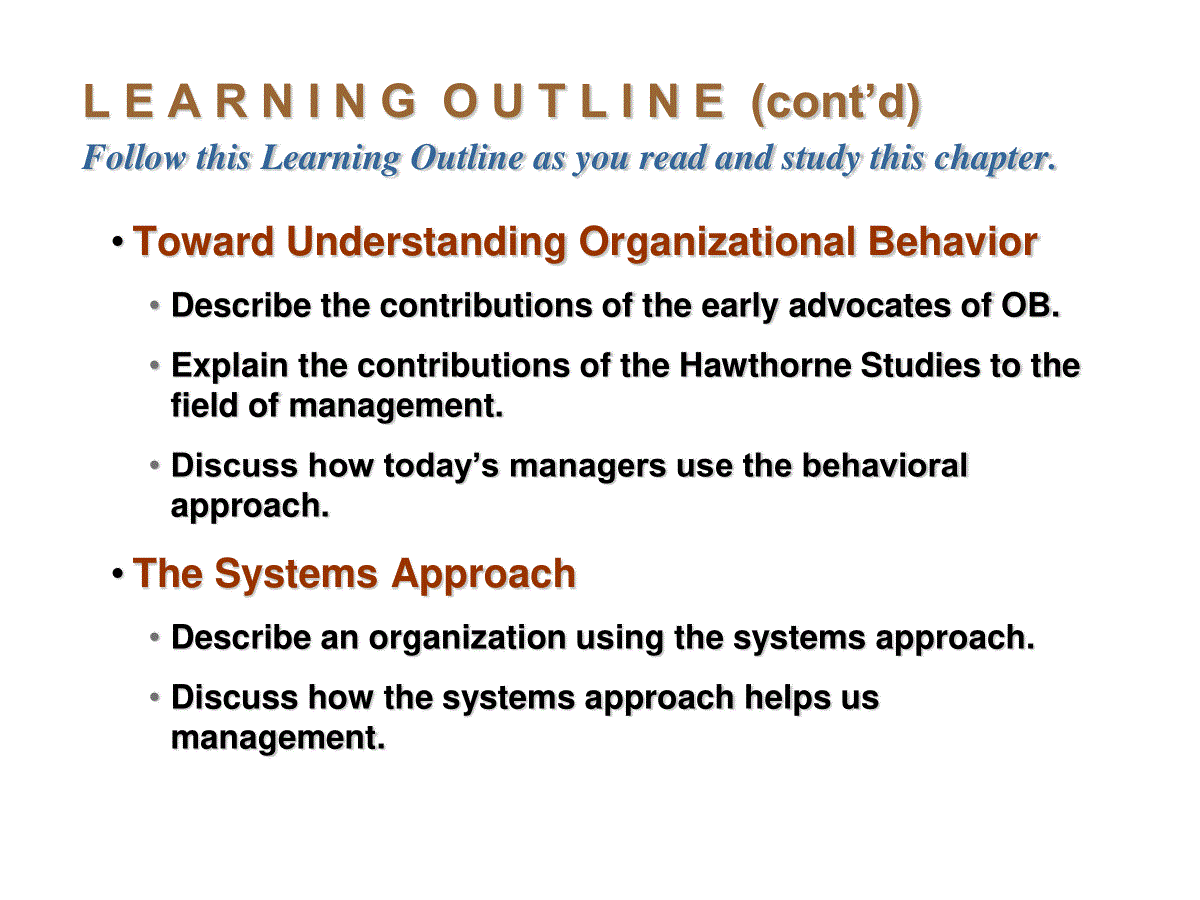当前位置:首页 > 商业/管理/HR > 经营企划 > 中山大学国际商学院管理学chap02
nintheditionSTEPHENP.ROBBINSPowerPointPresentationbyCharlieCookTheUniversityofWestAlabamaMARYCOULTERManagementYesterdayandTodayChapter2LecturerZhangXuezhizhxuezhi@mail.sysu.edu.cn13710600601LEARNINGOUTLINEFollowthisLearningOutlineasyoureadandstudythischapter.•HistoricalBackgroundofManagement•Explainwhystudyingmanagementhistoryisimportant.•Describesomeearlyevidencesofmanagementpractice.•ScientificManagement•DescribetheimportantcontributionsmadebyFredrickW.TaylorandFrankandLillianGilbreth.•Explainhowtoday’smanagersusescientificmanagement.LEARNINGOUTLINE(cont’d)FollowthisLearningOutlineasyoureadandstudythischapter.•GeneralAdministrativeTheory•DiscussFayol’scontributionstomanagementtheory.•DescribeMaxWeber’scontributiontomanagementtheory.•Explainhowtoday’smanagersusegeneraladministrativetheory.•QuantitativeApproach•Explainwhatthequantitativeapproachhascontributedtothefieldofmanagement.•Discusshowtoday’smanagersusethequantitativeapproach.LEARNINGOUTLINE(cont’d)FollowthisLearningOutlineasyoureadandstudythischapter.•TowardUnderstandingOrganizationalBehavior•DescribethecontributionsoftheearlyadvocatesofOB.•ExplainthecontributionsoftheHawthorneStudiestothefieldofmanagement.•Discusshowtoday’smanagersusethebehavioralapproach.•TheSystemsApproach•Describeanorganizationusingthesystemsapproach.•Discusshowthesystemsapproachhelpsusmanagement.LEARNINGOUTLINE(cont’d)FollowthisLearningOutlineasyoureadandstudythischapter.•TheContingencyApproach•Explainhowthecontingencyapproachdiffersfromtheearlytheoriesofmanagement.•Discusshowthecontingencyapproachhelpsusunderstandmanagement.•CurrentIssuesandTrends•Explainwhyweneedtolookatthecurrenttrendsandissuesfacingmanagers.•Describethecurrenttrendsandissuesfacingmanagers.HistoricalBackgroundofManagement•AncientManagementEgypt(pyramids)andChina(GreatWall)Venetians(floatingwarshipassemblylines)•AdamSmithPublished“TheWealthofNations”in1776Advocatedthedivisionoflabor(劳动分工)(jobspecialization,工作专门化)toincreasetheproductivityofworkers•IndustrialRevolutionSubstitutedmachinepowerforhumanlaborCreatedlargeorganizationsinneedofmanagement管理的历史背景(中国)•治国思想“行仁德之政”、“因民之所利而利之”、“从民所欲,去民所恶,乃为政之宝”•《孙子兵法》——“为将之道”的战略强调调查:“兵者,国之大事,死生之地,存亡之道,不可不察也”强调环境分析:“故经之以五事校之以计而索其情:一曰道,二曰天,三曰地,四曰将,五曰法。”强调对比分析:“知彼知己,百战不殆,不知彼而知自己,一胜一负,不知彼,不知己,每战必殆。”•儒家思想“仁、义、理、智、信”2019/9/98抓霸放色:管仲的齐国CEO之道•从某种程度上来说,丞相之于天子,就像职业经理人之于老板。经营一个国家,与经营一个企业有着曲异同工之妙。•管仲是春秋战国时期,齐国“老板”齐桓公从鲁国聘请的著名“职业经理人”,在“齐管”这对黄金搭档配合下,将一个弱小的齐国经营成当时最为强大的霸主。•其经验与教训实在值得现代职业经理人借鉴。2019/9/99引进自己的高管团队•经鲍叔牙推荐,管仲与齐桓公谈了三天三夜,大有相见恨晚之意。齐桓公当即任命管仲为齐国丞相,但遭管仲拒绝。•就在齐桓公纳闷的时候,管仲不失时机地抛出了自己的团队观:“臣闻大厦之成,非一木之材;大海之润,非一流之归也。君必欲成其大志,则用五杰。”那“五杰”,即隔朋、宁越、成父、宾须无、东郭牙五人也。•作为一个杰出的CEO,管仲在向老板推荐自己的管理团队采取的策略是十分英明的。2019/9/910抓“霸”放“色”•在齐桓公与管仲的数十年合作经营中,首先是目标清晰——“举霸业,服天下”。•在齐桓公任用管仲之初曾担心:“我很好色,对霸业会有害吗?”管仲回答说:“无害!”当齐桓公问及什么对霸业有害时,管仲称:“不知贤,害霸;知贤不用,害霸;用而不任,害霸;任而复以小人参之,害霸。”•管仲的回答,齐桓公很高兴,于是,他把绝大多数政治和经济事务交给管仲全权办理,而自己则深居王宫,行“好色”之事,齐国反而强大起来。管仲改革•在全国划分政区,组织军事编制,设官吏管理;三十家为一邑,十邑为一卒,十卒为一乡,三乡为一县,十县为一属,全国共五属,设五大夫。•建立选拔人才制度,士经三审选,可为“上卿之赞”•“相地而衰征”----按土地分等征税;•发展盐铁业,铸造货币,设“轻重九府”,根据丰歉来收散粮食和物品,调剂物价。•外交上“尊王攘夷”。©2007PrenticeHall,Inc.Allrightsreserved.2–112019/9/912西方管理的伦理基础•新教伦理:勤奋、节俭、“天职”。•自由伦理:freedom;liberty。•市场伦理:竞争、契约。Exhibit2–1DevelopmentofMajorManagementTheories2–14MajorApproachestoManagement•ScientificManagement科学管理•GeneralAdministrativeTheory一般行政管理•QuantitativeManagement定量管理•OrganizationalBehavior组织行为•SystemsApproach系统方法•ContingencyApproach权变理论ScientificManagement•FredrickWinslowTaylor弗雷德里克.温斯洛.泰罗The“father”ofscientificmanagementPublishedPrinciplesofScientificManagement(1911)Thetheoryofscientificmanagement–Usingscientificmethodstodefinethe“onebestway”forajobtobedone:•Puttingtherightpersononthejobwiththecorrecttoolsandequipment.•Havingastandardizedmethodofdoingthejob.•Providinganeconomicincentivetotheworker.Exhibit2–2Taylor’sFourPrinciplesofManagement1.Developascienceforeachelementofanindividual’swork,whichwillreplacetheoldrule-of-thumbmethod.2.Scientificallyselectandthentrain,teach,anddeveloptheworker.3.Heartilycooperatewiththeworkerssoastoensurethatallworkisdoneinaccordancewiththeprinciplesofthesciencethathasbeendeveloped.4.Divideworkandresponsibilityalmostequallybetweenmanagementandworkers.Managementtakesoverallworkforwhichitisbetterfittedthantheworkers.ScientificManagement(cont’d)•FrankandLillianGilbrethFocusedonincreasingworkerproductivitythroughthereductionofwastedmotionDevelopedthemicrochronometertotimeworkermotionsandoptimizeworkperformanceTherbligs动作分类体系•HowDoToday’sManagersUseScientificManagement?UsetimeandmotionstudiestoincreaseproductivityHirethebestqualifiedemployeesDesignincentivesystemsbasedonoutputScientificManagement•整理资料:有一份文件共10页,有100份;现在第1页100份放在一叠,第2页….第10页也是如此。如何把它们重新分好100份,每份按页码排好?你一个人怎么做?如果是100页的文件,共10份呢?•拣选货物:仓库中有100种货物,你手里有10份订单,每个订单需要不同货物;你如何把这些货物拣选出来,并按订单分别堆放在指定位置?如果仓库中有10种货物,而你手中有100份订单呢?GeneralAdministrativeTheory•HenriFayolBelievedthatthepracticeofmanagementwasdistinctfromotherorganizationalfunctionsDevelopedfourteenprinciplesofmanagementthatappliedtoallorganizationalsituations•





 三七文档所有资源均是用户自行上传分享,仅供网友学习交流,未经上传用户书面授权,请勿作他用。
三七文档所有资源均是用户自行上传分享,仅供网友学习交流,未经上传用户书面授权,请勿作他用。
本文标题:中山大学国际商学院管理学chap02
链接地址:https://www.777doc.com/doc-848751 .html